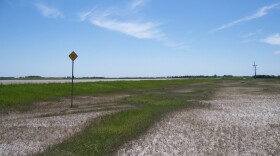No doubt many North Dakotans hear a loud, gurgling call emanating from overhead during spring or fall, and look skyward in search of the source. After a bit of searching, you finally identify the source as a flock of large birds, way up there! If the flock is lower, long legs might be visible sticking out behind them. Ahh, the call of sandhill cranes!
It is the birds' call that often catches our attention. Sometimes, sandhill cranes may be observed flying low overhead and easily identifiable. But they are frequently flying up so high that they are just about out of sight, so it’s the loud call that gives them away.
In “Life Histories of Familiar North American Birds,” author Arthur Cleveland Bent quotes Hamilton M. Laing’s interesting description of their call:
“It is a hoarse, unnatural croak that rips from the throat, a vibrant puttering that seems to suggest something prehistoric—such a call as one might expect that our far-gone ancestors heard in the days when pterodactyls and their kind flew about the marshes.”
Appearance and behavior
With a wingspan of around six and a half feet, they are a little smaller than their cousin, the whooping crane. Sandhill cranes are gray with a rusty tinge on the upper body, and a prominent red crown or forehead. Sandhill cranes are a bird of the marshes where they feed on a variety of items including worms, insects, frogs. seeds, and tubers.
Sandhill Cranes in North Dakota
In his book “Breeding Birds of North Dakota,” author Robert Stewart shows records of both whooping cranes and sandhill cranes nesting in the state. He noted observations of nests, eggs, young, or adults during the breeding season in several locations north and east of the Missouri River from the 1840s to the 1970s.
They were absent from the state for a while after that, but over the past few years, breeding pairs have been observed in at least one of our National Wildlife Refuges and probably other areas. So, perhaps the call of sandhill cranes will soon be heard during the summer months, as well.





